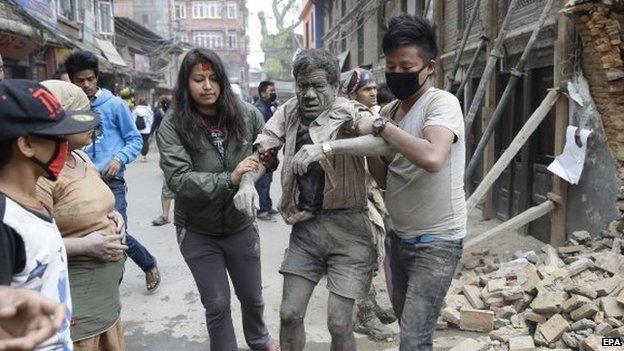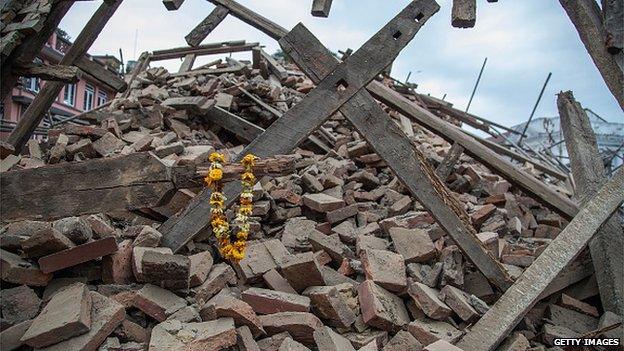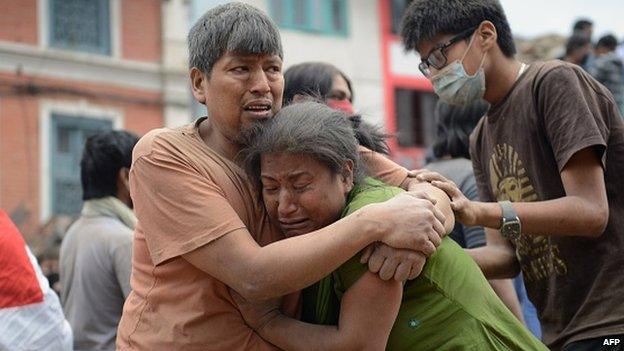Nepal quake: Relief operation faces challenges
- Published

In parts of the country, trapped victims are being dug out of the rubble by hand due to a lack of equipment
Nepal has been expecting this earthquake for a long time.
Scientists have been mapping the seismic pressure building up along the fault lines under the Himalayas for the past few decades.
The last major quake to hit Nepal's densely populated Kathmandu valley was in 1934. About 10,000 people were killed and there was widespread devastation.
Since then, the population of the valley has swelled to more than 2.5 million.
Kathmandu and the surrounding towns that dot the valley floor are now crammed full of new, overcrowded and often poorly constructed buildings.
The fear was that when the big quake hit, not only would thousands of people die as these buildings collapsed, but that poor infrastructure and the valley's remote location would make rescue efforts almost impossible.
As devastating as this quake is, this nightmare scenario of a totally isolated country unable to receive any aid has, thankfully, not come to pass.
After being shut for several hours, the runway at Kathmandu airport is now open to aid flights which will bring in crucial supplies.
The airport will also act as a base for helicopter flight to more remote parts of the country where the damage is still to be assessed.
For the moment, the humanitarian response is being led by India, which will be keen to establish its dominance in this politically sensitive region close to the Chinese border.
India will be working in conjunction with the Nepali government which, after the wake-up call of the devastating 2011 Haiti earthquake, has been developing an earthquake preparedness plan.

Many of Nepal's buildings were badly constructed
Earthquake drills
Most districts around the country now have earthquake committees. People have been educated on where to shelter during a quake, where to congregate afterwards and how to give basic first aid.
Hospitals and schools have been retrofitted to withstand tremors. The police, army and local Red Cross have practised rescue drills.
But the poor state of Nepal's infrastructure means it will still be an enormous challenge to first locate and rescue those buried alive, and then house and feed those made homeless.
Right now it is not clear whether the few roads in and out of the valley are open or not.
As some are close to the quake's epicentre, there is likely to be major damage from cracking and landslides.
There is heavy-lifting equipment in Kathmandu, but despite a recent road-widening programme, many roads are still too small for the equipment to travel through.
Outside the city, eyewitnesses report that people are trying to dig victims out of the rubble by hand because they have nothing else to use.
Power and water
The lack of electricity will be a problem over the coming days.
Kathmandu is used to long power cuts all year round and many people do have generators. But it is unclear how much petrol the city has - and whether more can be trucked in through damaged roads. It's also unclear whether the country's hydroelectric plants have been damaged.
Maintaining a clean water supply will become a major challenge for the rescue effort.

The situation outside Kathmandu may well be even worse - and reaching those in need will be difficult
Only some homes in Kathmandu have access to mains water. The rest rely on water tankers who drive in supplies every week, and who may not be able to reach the city.
The city is no stranger to cholera, which tends to hit during the summer rainy season.
There will be an acute risk of water-borne disease if people start to rely on the heavily polluted water of Kathmandu's Bagmati River and its tributaries.
Water filtration plants will need to be established very quickly to prevent this.
In addition, supplies of blood, medicine and food will need to shipped in quickly for those who are injured or left homeless.
Remote
As bad as this situation is, at least those in the valley have access to aid.
The thousands of people in Nepal's middle hills and more isolated western towns will have to cope on their own without medical, food and water supplies until helicopters can reach them - and this may take days.
This also applies to hundreds of climbers in the Everest region who have been hit by a deadly avalanche. Right now they will be relying on each other to rescue those trapped and bring them to safety.
Nepalis are tough people used to living in extreme circumstances, but the next few days will be testing for everyone.
And when the dust settles on the rescue effort, the focus will move onto the country's many historic buildings now reduced to piles of rubble.
Nepal may have been expecting this quake for a long time, but its legacy will take even longer to cope with.
Joanna Jolly was the BBC's Nepal correspondent from 2009 to 2011